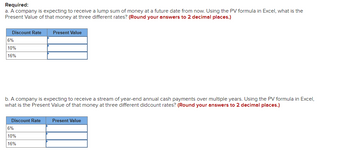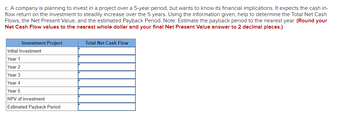
FINANCIAL ACCOUNTING
10th Edition
ISBN: 9781259964947
Author: Libby
Publisher: MCG
expand_more
expand_more
format_list_bulleted
Question
For each requirement, change the values of the given information as shown and keep all other original data the same. Then enter your updated final answers for each scenario.
Scenario A:
| Future value to be received | $ | 10,000 | |
| Future date received | 3 | years | |
| Discount Rate |
| 6% |
| 10% |
| 16% |
Scenario B:
| Annual Cash Receipt | $ | 5,000 | |
| Number of Years | 6 | years | |
| Discount Rate |
| 6% |
| 10% |
| 16% |
Scenario C:
Discount Rate 8%
| Investment Project | |||
| Initial Investment | $ | (6,500) | |
| Year 1 | $ | 700 | |
| Year 2 | $ | 800 | |
| Year 3 | $ | 1,400 | |
| Year 4 | $ | 3,600 | |
| Year 5 | $ | 6,800 | |
Required:
a. A company is expecting to receive a lump sum of money at a future date from now. Using the PV formula in Excel, what is the Present Value of that money at three different rates? (Round your answers to 2 decimal places.)

Transcribed Image Text:**Required:**
a. A company is expecting to receive a lump sum of money at a future date from now. Using the PV (Present Value) formula in Excel, what is the Present Value of that money at three different rates? *(Round your answers to 2 decimal places.)*
| Discount Rate | Present Value |
|---------------|---------------|
| 6% | |
| 10% | |
| 16% | |
b. A company is expecting to receive a stream of year-end annual cash payments over multiple years. Using the PV formula in Excel, what is the Present Value of that money at three different discount rates? *(Round your answers to 2 decimal places.)*
| Discount Rate | Present Value |
|---------------|---------------|
| 6% | |
| 10% | |
| 16% | |

Transcribed Image Text:### Investment Project Analysis
A company is planning to invest in a project over a 5-year period but wants to know its financial implications. It expects the cash inflow return on the investment to steadily increase over the 5 years. Using the information given, determine the Total Net Cash Flows, the Net Present Value, and the estimated Payback Period.
**Instructions:**
- Estimate the payback period to the nearest year.
- Round your Net Cash Flow values to the nearest whole dollar and your final Net Present Value answer to 2 decimal places.
#### Investment Project Table
| Investment Project | Total Net Cash Flow |
|-------------------------|---------------------|
| Initial Investment | |
| Year 1 | |
| Year 2 | |
| Year 3 | |
| Year 4 | |
| Year 5 | |
| NPV of Investment | |
| Estimated Payback Period| |
This table is used to calculate and document the financial outlook of the projected investment over the 5-year period.
Expert Solution
This question has been solved!
Explore an expertly crafted, step-by-step solution for a thorough understanding of key concepts.
This is a popular solution
Trending nowThis is a popular solution!
Step by stepSolved in 4 steps with 8 images

Knowledge Booster
Learn more about
Need a deep-dive on the concept behind this application? Look no further. Learn more about this topic, accounting and related others by exploring similar questions and additional content below.Similar questions
- Please provide the Payback period and Discounted Payback Period:arrow_forwardThe following information will be used to answer questions 8, 9, and 10. Your company can invest in 1 of the following projects: Cash Flows Year Project A Project B 0 -70.000 -65.000 1 30.000 8.000 2 10.000 8.000 3 10.000 8,000 4 18.000 9.000 O 5.000 30.000 6 4.000 40.000 The interest rate is 8%. 8a. What is the payback period for each project? 8b. If you base your decision on which project has the shortest payback, which will you choose?arrow_forwardInformation on four investment proposals is given below. Investment required Present value of cash inflows Net present value Life of the project Required: 1 Compute the profitability index for each investment proposal. Note: Round your answers to 2 decimal places. 2. Rank the proposals in terms of preference Investment Profitability Proposal Index A B C D S (150,000) 211,800 $61,500 Rank Preference 5 years Investment Proposal $(80,000) 110,400 $ 30,400 7 years $ (160,000) 241,600 $ 81,600 6 years D $ (910,000) 1.214,500 $ 304,500 6 yearsarrow_forward
- Cash Payback Period A project has estimated annual net cash flows of $30,000. It is estimated to cost $192,000. Determine the cash payback period. If required, round your answer to one decimal place.fill in the blank 1 yearsarrow_forwardInvestment Criteria. What is the NPV of a project that costs $250,000 and provides cash inflows of $50,000 annually for ten years and the discount rate is 10 percent? Should the project be accepted? Please show your workarrow_forwardThe management of Riker Inc. is exploring five different investment opportunities. Information on the five projects under study follow Project Number Investment required Present value of cash inflows at a 10% discount rate Net present value Life of the project Project 1 2 3 4 5 Profitability Index 1 2 3 $(390,000) $(330,000) $(350,000) 478,490 396,950 $ 88,490 $ 66,950 6 years 3 years First preference Second preference 433,190 $ (83,190) 5 years The company's required rate of return is 10%; thus, a 10% discount rate has been used in the preceding present value computations. Limited funds are available for investment, and so the company cannot accept all of the available projects. Third preference Fourth preference Fifth preference 4 $(330,000) Required: 1. Compute the profitability Index for each investment project. (Round your answers to 2 decimal places.) 300, 100 $ 29,900 12 years 5 $(480,000) 562,860 $82,860 6 years 2. Rank the five projects according to preference, in terms of (a)…arrow_forward
- Compute the discounted payback statistic for Project C if the appropriate cost of capital is 8 percent and the maximum allowable discounted payback period is three years. (Do not round intermediate calculations and round your final answer to 2 decimal places.) Project C Time: 0 1 2 3 4 5 Cash flow: –$1,000 $480 $480 $520 $300 $100arrow_forwardPlease answer fast please help arjentarrow_forwardtime value of money practice example: Please show calcualtions/steps (excell or other format): a) Calculate PB, DPB, NPV, IRR and PI for the following project: - discount rate of 12% - initial investment = 750,000 - ncf yr 1 = 150,000 - ncf yr 2 = 300,000 - ncf yr 3 = 400,000 - ncf yr 4 = 250,000 - ncf yr 5 = 100,000arrow_forward
- The following two alternatives are given. Data A B. First Cost $8,200 $5,600 Annual Cost $1,000 $800 Annual Benefit $2,700 $2,100 Life, Years 7. Salvage Value $2,800 $1,000 Assume that MARR is 15%. Use the incremental rate of return analysis to determine which alternative (A or B) one should choose. Find the AIRR, or a range of AIRR. O 10% O 10-12% O 12-15% O > 15%arrow_forwardAnnual cash inflows that will arise from two competing investment projects are given below: Year Investment A Investment B 1 $7,000 $ 10,000 2 8,000 3 9,000 4 10,000 $ 34,000 9,000 8,000 7,000 $ 34,000 The discount rate is 7%. Click here to view Exhibit 12B-1 and Exhibit 12B-2, to determine the appropriate discount factor(s) using tables. Required: Compute the present value of the cash inflows for each investment.arrow_forwardhelp please answer in text form with proper workings and explanation for each and every part and steps with concept and introduction no AI no copy paste remember answer must be in proper format with all workingarrow_forward
arrow_back_ios
SEE MORE QUESTIONS
arrow_forward_ios
Recommended textbooks for you

 AccountingAccountingISBN:9781337272094Author:WARREN, Carl S., Reeve, James M., Duchac, Jonathan E.Publisher:Cengage Learning,
AccountingAccountingISBN:9781337272094Author:WARREN, Carl S., Reeve, James M., Duchac, Jonathan E.Publisher:Cengage Learning, Accounting Information SystemsAccountingISBN:9781337619202Author:Hall, James A.Publisher:Cengage Learning,
Accounting Information SystemsAccountingISBN:9781337619202Author:Hall, James A.Publisher:Cengage Learning, Horngren's Cost Accounting: A Managerial Emphasis...AccountingISBN:9780134475585Author:Srikant M. Datar, Madhav V. RajanPublisher:PEARSON
Horngren's Cost Accounting: A Managerial Emphasis...AccountingISBN:9780134475585Author:Srikant M. Datar, Madhav V. RajanPublisher:PEARSON Intermediate AccountingAccountingISBN:9781259722660Author:J. David Spiceland, Mark W. Nelson, Wayne M ThomasPublisher:McGraw-Hill Education
Intermediate AccountingAccountingISBN:9781259722660Author:J. David Spiceland, Mark W. Nelson, Wayne M ThomasPublisher:McGraw-Hill Education Financial and Managerial AccountingAccountingISBN:9781259726705Author:John J Wild, Ken W. Shaw, Barbara Chiappetta Fundamental Accounting PrinciplesPublisher:McGraw-Hill Education
Financial and Managerial AccountingAccountingISBN:9781259726705Author:John J Wild, Ken W. Shaw, Barbara Chiappetta Fundamental Accounting PrinciplesPublisher:McGraw-Hill Education


Accounting
Accounting
ISBN:9781337272094
Author:WARREN, Carl S., Reeve, James M., Duchac, Jonathan E.
Publisher:Cengage Learning,

Accounting Information Systems
Accounting
ISBN:9781337619202
Author:Hall, James A.
Publisher:Cengage Learning,

Horngren's Cost Accounting: A Managerial Emphasis...
Accounting
ISBN:9780134475585
Author:Srikant M. Datar, Madhav V. Rajan
Publisher:PEARSON

Intermediate Accounting
Accounting
ISBN:9781259722660
Author:J. David Spiceland, Mark W. Nelson, Wayne M Thomas
Publisher:McGraw-Hill Education

Financial and Managerial Accounting
Accounting
ISBN:9781259726705
Author:John J Wild, Ken W. Shaw, Barbara Chiappetta Fundamental Accounting Principles
Publisher:McGraw-Hill Education